
Previously, users had to flatten records and lists manually. With the addition of automatic table detection capabilities, using the JSON connector in Power Query will automatically apply transformation steps to flatten the JSON data into a table. Here is an example of JSON file with multiple levels of nested data. Importing data from JSON files (or Web APIs) can be challenging for end users. Automatic table detection from JSON files To load a JSON file from the web, select the Web connector, enter the web address of the file, and follow any credential prompts. More information: Automatic table detection from JSON files From the editor, you can then continue to transform the data if you want, or you can just save and close to load the data. Power Query uses automatic table detection to seamlessly flatten the JSON data into a table. Loading the JSON file will automatically launch the Power Query Editor.

If authentication is required, enter your credentials. Select an on-premises data gateway from Data gateway. Load a local JSON file from Power Query Online From the editor, you can then continue to transform the data if you want, or you can just close and apply. This selection launches a local file browser where you can select your JSON file. Select the JSON option in the Get Data selection.

Load a local JSON file from Power Query Desktop Some capabilities may be present in one product but not others due to deployment schedules and host-specific capabilities.


 0 kommentar(er)
0 kommentar(er)
